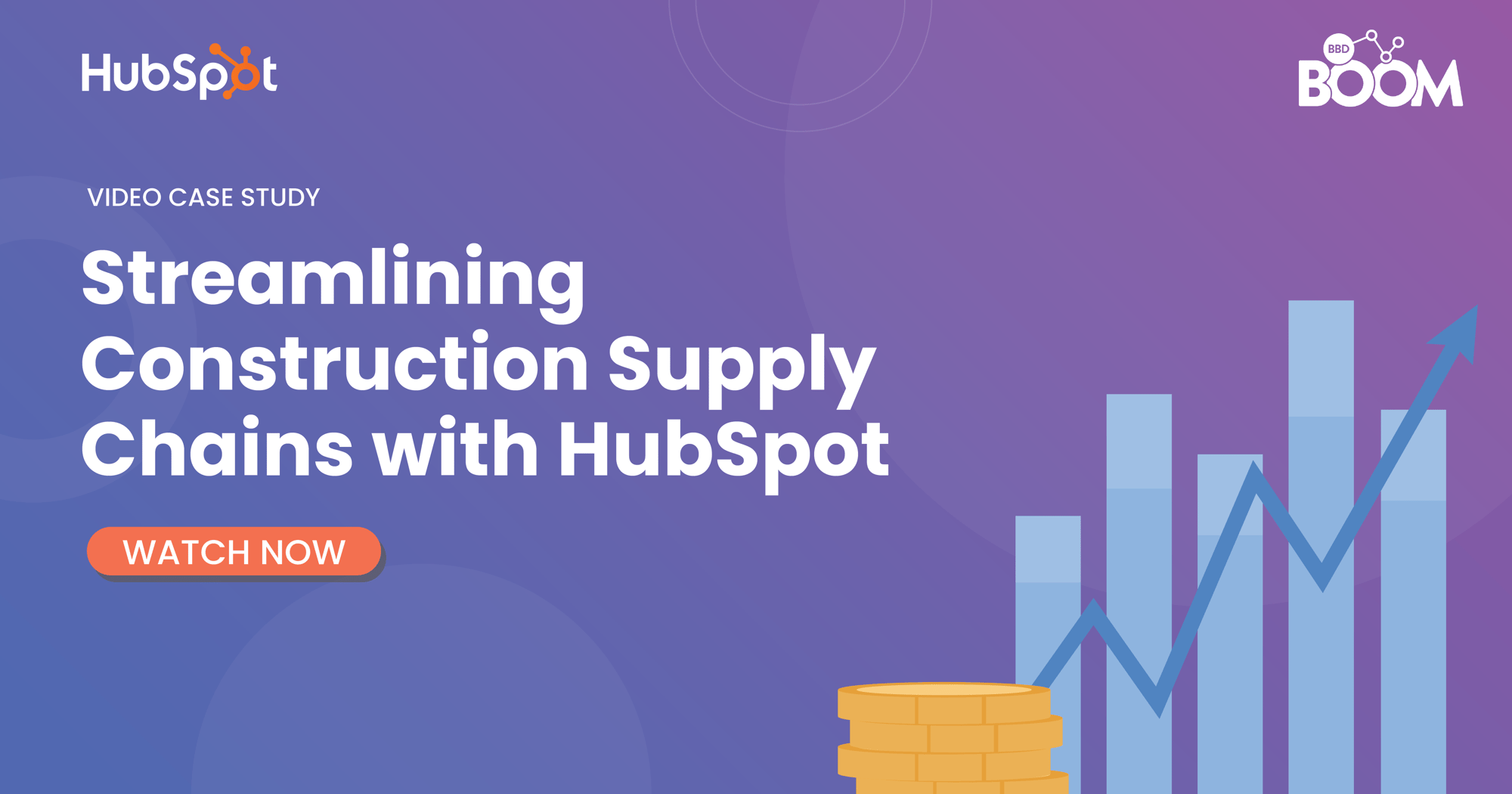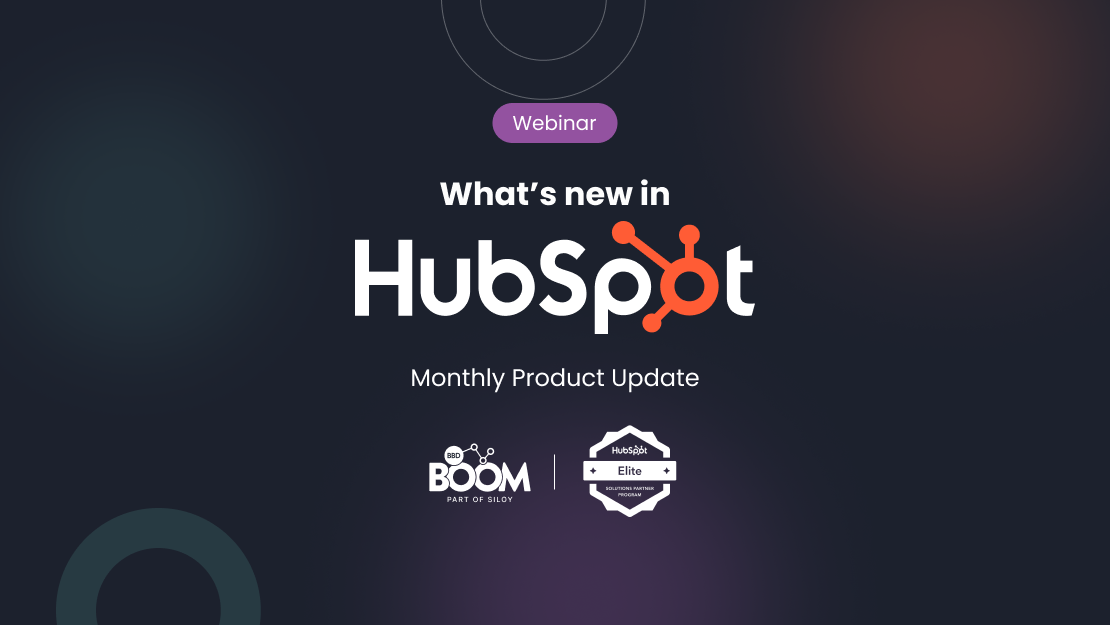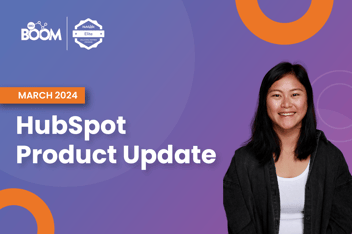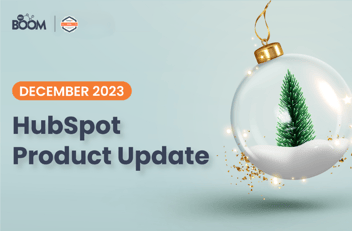Welcome to our HubSpot Product Spotlight for January. In this blog, we’ll explore some of the team's favourite HubSpot updates from the last month.
Ready? Let’s dive in!
Now Live
These are all the new features live and ready to use in your HubSpot portal.
1. New HubSpot Subdomains
What is it?
HubSpot is now sending email from subdomains of '@hubspot.com'.
Why does it matter?
Many recipients have inbox routing rules configured to help manage their email. Moving forward, HubSpot emails will come from a variety of subdomains, and we encourage you to be on the lookout for incoming mail.
2. Move inbox channels and conversations to Help Desk
What is it?
Admins can now move an existing email or form channel from the inbox to help desk. They can also choose to move historical conversations and associated tickets to help desk when moving the channel.
Why does it matter?
Many of our customers have existing email and forms channels connected to inboxes that they want to bring to help desk, and are finding it difficult to utilise the new help desk workspace without a simple way to move their channels and historical conversations/tickets into help desk.
3. Social Composer Draft Experience
What is it?
Marketers can now create their social posts faster than ever, with the new draft option on iOS and Android. Creating content simultaneously for all your social networks, now it’s possible!
Why does it matter?
Social media content creators have had difficulty creating content for multiple networks on mobile. Now with the new draft feature, you can:
1) more quickly create and edit posts for all your network, including the publish time and campaign
2) more clearly see existing features and new features at your fingertips for social post creation
3) more easily learn how to create social media posts on mobile, as the new experience follows a familiar pattern & UI in other content creation tools within HubSpot's ecosystem and desktop Social.
4. SPF/DMARC for All
What is it?
'SPF & DMARC for All' will add SPF and DMARC records to the 'Connect an Email Sending Domain' flow, and expose connection status directly in HubSpot. Customers will now be able to:
- Copy DMARC and SPF records directly from HubSpot to their DNS
- Check the connection status for DMARC, DKIM, and SPF directly in HubSpot
Why does it matter?
Starting February 2024, Google and Yahoo will be requiring DMARC, DKIM and SPF for all bulk senders. Moving forward, any bulk sender who does not have all three authentication measures in place will be blocked or directed to spam. By adding SPF and DMARC to the connection flow, customers will now be able to manage their email authentication directly in HubSpot.
5. One Click Unsubscribe
What is it?
Updating email headers to be compliant with one-click unsubscribe requirements.
Why does it matter?
Google / Yahoo have announced that starting February 2024, they will be enforcing one-click unsubscribe. To ensure our emails are compliant we need to make updates to our current email header format. You may see a spike in unsubscribe rates once this is released.
6. Enroll in a HubSpot Sequence and Book a Meeting from NetSuite
What is it?
Enroll in a sequence directly or book a HubSpot meeting directly from within NetSuite.

Why does it matter?
If you're using NetSuite as your CRM and HubSpot for prospecting, you can now enroll in a sequence or book meetings from a contact, lead, prospect, or customer in NetSuite through the HubSpot Embed. No need to jump back and forth between HubSpot and NetSuite like before.
7. Enroll in a HubSpot Sequence and Book a Meeting from Microsoft Dynamics
What is it?
Enroll in a sequence directly or book a HubSpot meeting directly from within Microsoft Dynamics 365.

Why does it matter?
If you're using Dynamics 365 as your CRM and HubSpot for prospecting, you can now enroll in a sequence or book meetings from a contact or lead record in Dynamics 365 through the HubSpot Embed. No more jumping back and forth between HubSpot and Dynamics 365 like before.
8. Currencies API
What is it?
The currencies API is now live and available for use, offering you a new way to manage your multicurrency experience in HubSpot. With the currencies API, you can manage the currencies used in your HubSpot account, including setting your account's company currency, creating additional currencies, and updating currency exchange rates.
This will serve two customer segments:
- Customers who wish to build a custom integration for their account, and
- HubSpot partners who build marketplace apps that any HubSpot customer can install
Using the API, you can integrate a HubSpot account to an external source for automated, dynamic foreign exchange rate updates for the currencies set up in the account.
Why does it matter?
This API provides HubSpot customers with more options to managing currencies, rather than having to manually enter and update the exchange rates in "Currency Settings". Using the API, you can link to a trusted source for exchange rate updates, and schedule updates, in order to reflect market rates without manual intervention--reducing room for human error or missed updates.
9. DocuSign Integration Enhancements
What is it?
We've seen tremendous customer enthusiasm for our DocuSign integration on HubSpot, so now we're releasing several major enhancements to extend its functionality:
- Custom field mappings: You can now set your own custom mappings between HubSpot and DocuSign fields.
- Design enhancements: You will notice the addition of new scroll bars, buttons and tooltips within the application, a new feature card, and a connection status page under Settings.
- Stability and performance: The DocuSign application now has faster loading time and many fewer errors.
Why does it matter?
These enhancements deepen the functionality and utility of the DocuSign integration, and open up a range of new use cases where you can grow the power of the HubSpot platform with DocuSign.
10. All your To-Dos in one place! Meetings + Tasks now on Mobile
What is it?
Mobile Calendar made it simpler to view and create new meetings on the go. Now you can view your tasks for the day in the same place too!

Why does it matter?
Up until now, viewing tasks and meetings were two separate items on mobile. To see meetings, you would need to tap into your calendar. To view tasks, you would need to go back in the home screen and tap into tasks. We’ve make it easier to take control of your schedule by combining meetings and tasks accessible from the same screen.
11. Custom Code Descriptions
What is it?
You can now provide an optional description for your custom code action that will also display on the action card when viewing your workflow.
Why does it matter?
The Custom Code action was always a black box when viewing a workflow at a glance, as the action card just said "Defined by custom code", or for non-technical folks who are trying to decipher the code. This was always made worse when workflows contained multiple custom code actions and it was hard to tell which one was which.
The ability to provide a brief description of the action creates a more straightforward workflow-building process, while also encouraging better collaboration amongst teams of varying skillsets and levels.
12. Opt-out cookie consent banner type
What is it?
The new 'opt-out' banner broadens HubSpot's cookie management toolkit, specifically for areas with more lenient data privacy regulations compared to the EU. It permits cookies to track visitors by default, while still empowering them to opt out at any point.
Why does it matter?
As cookie management regulations differ globally, HubSpot's 'opt-out' banner provides a flexible alternative to the 'opt-in' banners required in strict regions like the EU. This feature supports default user tracking with the ability to opt out, aligning with less stringent compliance standards and optimizing data collection in applicable regions.
13. Explicit View/Edit Permissions for Feedback Surveys
What is it?
Prior to this change, all users who had “Service Access” had access to the feedback surveys tool by default. With this change, Admins can control whether a user who has “Service Access” should be able to access “Feedback Surveys” or not.
This change also enables Admins to grant explicit permissions for Viewing and Editing feedback surveys.
Users who have the “Edit” permissions will be able to create, publish and also delete feedback surveys.
Users who have the “View” permissions only will be able to see the surveys and responses, but will not be able to create, publish or delete feedback surveys.
Why does it matter?
Customers would like to offer permissions to create, edit, publish feedback surveys to only certain team members rather than providing access to all service team members. This could ensure that only the right team members reach out to customers to collect feedback.
14. Unread notifications indicator
What is it?
The unread notifications indicator gives you a way to see at a glance if you’ve got unread push notifications without having to navigate to the mobile notification centre.

Why does it matter?
The mobile notification centre gave users a way to ensure that users would never miss a push notification again. Previously, users would only be able to check if they had unread messages by tapping into the notification centre itself.
Nobody likes to wait around for the phone to ring. Similarly refreshing a notification centre is almost as painful. The unread notifications indicator allows users to take control, while simultaneously making it easier for them to check their messages.
15. Redesigned Workflow Action Experience
What is it?
The workflows tool has gotten a new, updated look.
Why does it matter?
The experience of building workflows can be chaotic. There are so many different actions, customers can't always find what they're looking for and when they see new actions they don't always feel confident to try them out. And when a workflow is sprawling and complex, it can be difficult to understand what's happening at a glance. Through this redesign, we are creating a more focused and guided building experience, while also making it easier to discover and use new functionality.
The redesigned workflows experience includes:
- Redesigned action and trigger cards to help keep the overall view concise and focused on the most important details
- A reorganized action panel, removing the long unruly list of actions and providing a more structured and searchable list
- Improved contextual guidance to help choose the right action for the right job
- An easier path to discover, connect and use workflow integrations.
16. Data Sync search by email address
We're happy to announce the release of new feature improvements for our existing Data Sync monitoring tool. These enhancements are designed to provide you with even more control and flexibility when it comes to analysing your data.
What is it?
- We have introduced the ability to search contact records using the email address, expanding the search capabilities beyond name parameters and IDs.
- You can now choose to display 25, 50, or 100 records per page on the record view of our sync performance tool, aligning this feature with the search experience in the CRM.
- We have tweaked the processing animation on the record view, making it more clear the sync is in a processing state.
Why does it matter?
Every active Data Sync connection has its own sync performance overview, showcasing the specific records that are being synchronised, as well as those that are not. Continuous improvement of this functionality is essential in enabling customers to easily conduct their own investigations.
17. Marketing Calendar Usability Improvements
What is it?
We're introducing a handful of usability improvements to the Marketing Calendar. These updates include:
- A new "List view" to provide an overview of events across an entire month
- Increasing the minimum height of the Marketing Calendar allowing more events to be viewed at once
- Re-arrangement of some of the buttons to improve usability
Why does it matter?
The marketing calendar enables marketing teams to stay aligned on the messaging going out, the channels being used (or overused), and generally help keep on top of what the whole team is working on.
Over time, the Marketing Calendar has supported an increasing number of marketing channels. This brings with it a collection of new usability challenges, particularly around information density. If information isn't easily accessible on the Marketing Calendar, it can be difficult to make the best decision on timing and targeting for your next social post, email, etc.
This round of usability improvements is focused on addressing this, and improving the scalability of the Marketing Calendar as we introduce more channels/assets in the future.
18. New Permissions setting to control who can create, edit subscription types
What is it?
The ability to create and/or edit subscription types on the Subscriptions settings page is now separated from the marketing email permissions.
With this rollout, HubSpot users who have the 'Add & edit users' permissions can now disable the ability to create and/or edit subscription types for new and existing users in their HubSpot account within the Marketing tab.
Why does it matter?
Not every portal user in HubSpot should have the ability to add, edit, or delete email subscription types. Now you have a permission setting to indicate who should and should not have that ability.
19. New permission setting to control who can access audit logs
What is it?
With this rollout, HubSpot users who have the 'Audit Log Access' permission toggled on can view the Audit Log feature in their HubSpot account.
Why does it matter?
By default, only Super Admins can view their account's Audit Log. Now there is a permission setting to indicate any other user on the account who should have that ability.
20. Sync NetSuite Status Field to HubSpot
What is it?
The NetSuite status field is now available to sync two-way for contacts and companies with the Netsuite app for HubSpot.
Why does it matter?
Prior to this update, you could not find the status field within the dropdown list making it impossible to map.
With the status field in the NetSuite app for HubSpot, you can now categorise your marketing leads into NetSuite as leads, prospects as prospects, and customers as customers.

21. Save and reuse groups of workflow actions with Action Sets
What is it?
You can now save a group of workflow actions into an Action Set so that you, and the rest of your team, can re-use. Action Sets are available for all Enterprise portals with workflows access.
Why does it matter?
Action Sets not only speed up the process of creating workflows but also give your workflow admins the ability to create guides for the rest of their teams to leverage while they're making workflows!
Building workflows can be a time-consuming process, but a lot of the time customers are reusing the same groups of actions across multiple workflows. Currently they either have to rebuild the workflow each time, clone the entire workflow, or copy and paste action by action. This results in human error and inconsistencies across workflows.
Workflow problems are exacerbated when there are teams creating workflows. Best practices are not easily enforced in the app, users all have different workflows knowledge levels, and it's harder to maintain and manage a quickly growing library of workflows. Managers or leads of larger teams lack the tools to help enforce best practices and guide the rest of their teams when creating workflows to simplify the process and create peace of mind for everyone.
22. Initiate WhatsApp and Email Conversations via Omnichannel Inbox Composer
What is it?
Users can now initiate email and WhatsApp conversations via the "Compose" button in Conversations Inbox.

Why does it matter?
Inbox users may need to initiate conversations via several channels from the Conversations Inbox to meet their customers where they are.
In the past, users were able to initiate email conversations but would have to wait for their contacts to initiate conversations via WhatsApp to communicate via this channel. Moving forward, the ability to start communications via WhatsApp and email will be easily accessible from the unified omnichannel composer in Conversations Inbox.
23. Visualize Associations
What is it?
A visual representation of associations between object types including association labels and limits. Additional information is now easily accessible about association labels within the data model overview and we’ve added a new, associations-specific view.
Why does it matter?
Associations can be confusing. As we’ve added more complexity to that system with a web of labels and limits, customers need some way to easily understand what’s configured and how it will impact their users.
24. Coming 1/11: partner admins can turn AI Assistant settings on/off for clients
What is it?
Previously, only portal super admins were able to turn AI Assistant settings ON or OFF inside of a portal.
Starting on 1/11/24, we will update permissions to the AI Assistant settings so that partners with the Partner Admin role can turn the "Content prompts" and "Customer analysis" settings on or off inside of a client portal.
Why does it matter?
Partners needed to go through an account super admin to enable or disable AI Assistant settings inside of a client portal, creating additional steps and blockers. Following partner feedback, we will allow partners with admin access to change this setting for clients.
Beta
These updates are currently in the works and nearly ready to be released on your HubSpot Portal.
1. Customise Default Deal Name
What is it?
Admins will be able to customize the default deal name for deals created from existing contact and company records. Previously HubSpot’s deal name default was not configurable and led to lots of customer frustration. Customers will be able to configure the default deal name within the “Create deal” form in Settings using a combination of personalization tokens and/or static text.
Why does it matter?
Currently the default for deal name for deals while on an existing contact and company records is that “-New Deal” is always added after either the company or contact name, which is both inflexible and contributes to poor data quality. This new functionality allows admins to configure the default experience to fit their own naming conventions and ensure data quality. Reps can spend less time on manual data entry while ensuring they’re following the right naming conventions.
2. Import an opt-out list for a specific business unit
What is it?
Users can now target a specific business unit when importing an opt-out list.
Why does it matter?
Previously, you were only able to import opt-out lists for the account default business unit. This meant that users who wanted to opt contacts out of communication from a different business unit had to manually do so after importing, or set up automated workflows that handled this process. This process simply did not scale for upmarket customers when they updated subscription preferences, and could lead to an incorrect number of billable contacts in their portal. With this new functionality, it will be much easier for admins to manage the opt-out process for their contacts in one import, saving them time as they manage their contact database.
3. New Ads Attribution Filters
What is it?
HubSpot users now have access to 4 new refreshed ads attribution filters that paint a clearer picture of their contacts' journeys.
Why does it matter?
Viewing the full funnel ROI of advertising campaigns is one of the best parts of the Ads tool. We currently provide ad tracking allowing you to see which customers have an ad interaction on their contact record. We combine this data with analytics data to provide attribution filters that showcase the journey which their contacts took when interacting with your ads.
However, our previous attribution filters were daunting, especially for first-time advertisers.
At HubSpot, we want to empower our customers to be able to understand the path that their contacts take. We have completely overhauled our attribution system to make our data faster and our attribution filters easier to understand.
4. New list creation flow & the ability to sort by when records were added
What is it?
Three key updates to the list creation experience:
- See records that meet your filter criteria while your list is still processing
- See all records that meet your filter criteria as soon as a list is complete
- Sort by the 'Added to List Date' column on any list
Why does it matter?
- See records during list processing:
- When creating a list, it can be helpful to analyse a few records to ensure they match your criteria expectations. Previously, you had to wait until the list was done processing to analyse each record by clicking 'preview' or opening the record in a new tab. Now, you can do this while the list is still processing!
- See all records when a list is complete:
- Previously, when a list was complete, it was common for the records in the table not to match the final list count for a short period of time. Now, as soon as a list is complete, you will see all the records in the table that match the final list count. Thus you can feel confident when using your list for e-mails, reporting, or automation.
- Sort by 'Added to List Date' column:
- Once a list is complete, sorting by the 'Added to List Date' helps you better track the performance of your lists over time.
5. Enable Double Opt-In for forms
What is it?
Historically, it was only possible to enable/disable double opt-in for select pages created in HubSpot.
With this change, you may choose to enable/disable double opt-in for select pages AND select forms of your preference.
There are also some updates to action descriptions/copy to make it clearer.

Why does it matter?
You have flexibility to apply double opt-in selectively, per form. For example, if it is mandatory in certain countries but not in others, you can choose which HubSpot forms use double opt-in and which ones do not.
6. 'Advanced Filters' Redesign for Index Pages
What is it?
We've updated index page filters to be more performant, allowing us to more easily build new filters functionality and make filters more consistent with the lists tool. The redesigned component aims to improve upon the existing filters component - removing clicks and allowing you to view your existing filters as you edit.

Why does it matter?
Those who create complex filters on index pages will likely benefit most from this update - especially those who also work with the lists tool. We've carried over the same filter patterns from lists to make groups more prominent and clear, as well as making it easy to see the filters you have while in the edit process.
7. Proactive Alerts for New Duplicates
What is it?
Introducing the ability to proactively monitor new duplicates and receive notifications. This includes an addition to data monitoring in the data quality command center. Users will also have the ability to subscribe themselves and other users to notifications triggered by the new duplicate alerts.
Why does it matter?
The new customizable duplicate notification allows operations managers to stay on top of duplicate records without getting distracted by insignificant changes. By selecting whether to monitor companies, contacts, or both, the frequency of notifications, and who receives them, users can focus on duplicate spikes that matter. This prevents getting overwhelmed with unactionable alerts so Ops teams can efficiently prioritize major duplicate issues impacting data quality.
.png?width=877&height=508&name=bbd-boom-siloy-navy+blue-logo%20(1).png)
.png)




-1.png)








